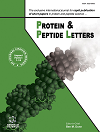- Home
- A-Z Publications
- Protein and Peptide Letters
- Previous Issues
- Volume 31, Issue 8, 2024
Protein and Peptide Letters - Volume 31, Issue 8, 2024
Volume 31, Issue 8, 2024
-
-
Bioactive Peptides from Marine Organisms
More LessAuthors: Peixin Wang, Yi Zhang, Jiamiao Hu and Bee Kang TanMarine organisms represent promising bioactive peptide resources with diverse biological activities such as antioxidant, antimicrobial, antihypertensive, anti-fatigue, and immunoregulatory activities. Despite many studies on marine bioactive peptides, there is a dearth of comprehensive review articles on the emerging trends that encompass the production techniques and the biological applications of mar Read More
-
-
-
Macromolecular Polymer Based Complexes: A Diverse Strategy for the Delivery of Nucleotides
More LessThis review explores the burgeoning field of macromolecular polymer-based complexes, highlighting their revolutionary potential for the delivery of nucleotides for therapeutic applications. These complexes, ingeniously crafted from a variety of polymers, offer a unique solution to the challenges of nucleotide delivery, including protection from degradation, targeted delivery, and controlled release. The focus of this report is prima Read More
-
-
-
Exploring the Potential Long-term Impact of SARS-CoV-2 on Protein Misfolding and Amyloid-related Conditions
More LessAuthors: Md Harun Rashid, Srinjana Singha, Faheem Arshad and Priyankar SenThe long-term impact of the COVID-19 pandemic concerns risk to human health, particularly its potential association with protein misfolding and amyloidosis. This review article explores the causality relationship between SARS-CoV-2 infection, and protein misfolding, leading to amyloid-related conditions. It delves into the mechanisms by which viral proteins may accelerate amyloid formation, exacerbating post-infection complic Read More
-
-
-
Different VH3-binding Protein A Resins Show Comparable VH3-binding Mediated Byproduct Separation Capabilities Despite Having Varied Dynamic Binding Capacities Towards A VH3 Fab
More LessAuthors: Lixia Hu, Rongrong Wang, Qinxue Wu, Yan Wan and Yifeng LiBackgroundProtein A resins have been widely used for product capture during mAb, bispecific antibody (bsAb), and Fc-fusion protein purification. While Protein A ligands mainly bind the Fc region, many of them can also bind the VH3 domain. During mAb/bsAb purification, certain truncated byproducts may contain the same Fc region as the product but fewer numbers of the VH3 domain. In such a scenario, VH3-binding Prot Read More
-
-
-
Expression, Purification, and Evaluation of Antibody Responses and Antibody-Immunogen Complex Simulation of a Designed Multi-Epitope Vaccine against SARS-COV-2
More LessAuthors: Ghadir A. Jamal, Ehsan Jahangirian and Hossein TarrahimofradBackgroundThe spread of the COVID-19 disease is the result of an infection caused by the SARS-CoV2 virus. Four crucial proteins, spike (S), membrane (M), nucleocapsid (N), and envelope (E) in coronaviruses have been considered to a large extent.ObjectiveThis research aimed to express the recombinant protein of a multiepitope immunogen construct and evaluate the immunogenicity of the multiepitope vaccine t Read More
-
-
-
Insights into the Evolutionary Dynamics: Characterization of Disintegrin and Metalloproteinase Proteins in the Venom Gland Transcriptome of the Hemiscorpius lepturus Scorpion
More LessAuthors: Abbas Rami, Benjamin Damizadeh, Mahdi Behdani and Fatemeh Kazemi-LomedashtBackgroundThe Disintegrin and Metalloproteinase (ADAM) family, also known as the metalloproteinase/disintegrin/cysteine-rich (MDC) proteins, includes both secreted and transmembrane molecules involved in critical biological processes, such as cell migration, adhesion, and signaling. This study aimed to investigate the evolutionary relationships and structural characteristics of disintegrin and metalloproteinase proteins ide Read More
-
Volumes & issues
-
Volume 32 (2025)
-
Volume 31 (2024)
-
Volume 30 (2023)
-
Volume 29 (2022)
-
Volume 28 (2021)
-
Volume 27 (2020)
-
Volume 26 (2019)
-
Volume 25 (2018)
-
Volume 24 (2017)
-
Volume 23 (2016)
-
Volume 22 (2015)
-
Volume 21 (2014)
-
Volume 20 (2013)
-
Volume 19 (2012)
-
Volume 18 (2011)
-
Volume 17 (2010)
-
Volume 16 (2009)
-
Volume 15 (2008)
-
Volume 14 (2007)
-
Volume 13 (2006)
-
Volume 12 (2005)
-
Volume 11 (2004)
-
Volume 10 (2003)
-
Volume 9 (2002)
-
Volume 8 (2001)
Most Read This Month
Article
content/journals/ppl
Journal
10
5
false
en


